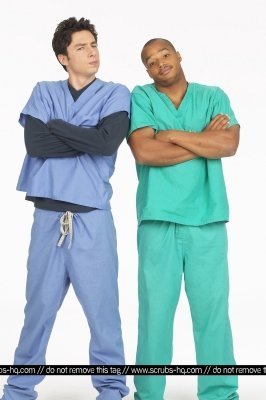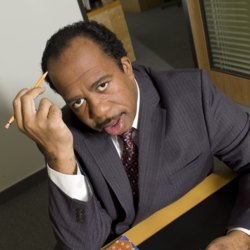
Almost everybody will agree that the portrayal of African Americans in popular culture has come along way since the early 1900s. We no longer see true mistral shows and the traditional black-face that was common nearly a century ago would be seen as highly offensive and racist if it were shown on television or in films today. But there are those that argue that African Americans are still not treated as equals in today’s media and that the characters they portray in many popular programs and movies still conform, at least partially, to the stereotypes that were present in the early days of cinema and TV. According to Bensoff and Griffin, “Since American cinema for the most part functions under the dominant ideology of white patriarchal capitalism, it should not be surprising to discover that most popular film helps maintain dominant cultural attitudes toward African Americans.”
The popular television show “Scrubs” provides excellent examples of how race is portrayed in pop culture. The show’s format is very similar to the buddy films of the 1980s and early 90s. JD, the white male lead, and Turk, the Black male lead, are best friends and doctors who both work at a busy hospital. Much of the show’s plot centers on these two doctors and the situations they find themselves in. According to Bensoff and Griffin, these buddy films were popular “because the biracial casting of the lead roles makes the film appeal to both black and white audiences. Hollywood producers don’t want to finance a ‘black’ film unless they are sure it will also attract white audiences, which usually means the casting of a white star alongside a black one.” This clip shows that the producers of “Scrubs” see Turk as JD’s equal and best friend, and that they don’t generally conform to the African American stereotypes of earlier generations.
While Turk certainly isn’t a blatant example of a Black Buck or Uncle Tom character, some may argue that there are elements of a Coon character in Chris Turk. He often finds himself in silly situations which make him appear a little like a buffoon, such as the example in this clip. We see Turk acting like a child just for the sake of getting a laugh. However, the difference between Turk and the full-blown Coon characters of the 1930s and 40s is that JD is always acting silly right along with Turk, and in many cases his behavior is even more outrageous than Turk’s. However, this doesn’t change the fact that Turk is black, and much of the show’s humor relies upon him acting silly and childlike. This Coon stereotype becomes even more apparent in scenes, like the following, where Turk dances. These scenes further that the stereotype that African Americans are good dancers, and in so doing, may appear racist to some viewers.
Another popular show that illustrates race in American media is “The Office.” While there a re no minorities that are cast in leading roles in the show, Daryl and Stanely are two minor African American characters that have both been on the receiving end of Michael’s insensitivity. This clip shows Michael’s insensitivity toward other cultures in general, and the final scene where Michael tells Stanely, “We don’t call them ‘collared people.’ That would be offensive,” is a typical example of how Michael Scott treats African Americans. The humor lies not in stereotypes or the buddy format, but in just how racially insensitive Michael is. In order to understand the humor, the audience must realize that the way Michael treats African Americans and other ethnic groups is wrong and socially unacceptable. While this is much different than humor derived from racial stereotypes, it is definitely offensive to some, and may also show that there is still a disparity between how African Americans and Caucasians are treated in American media.
re no minorities that are cast in leading roles in the show, Daryl and Stanely are two minor African American characters that have both been on the receiving end of Michael’s insensitivity. This clip shows Michael’s insensitivity toward other cultures in general, and the final scene where Michael tells Stanely, “We don’t call them ‘collared people.’ That would be offensive,” is a typical example of how Michael Scott treats African Americans. The humor lies not in stereotypes or the buddy format, but in just how racially insensitive Michael is. In order to understand the humor, the audience must realize that the way Michael treats African Americans and other ethnic groups is wrong and socially unacceptable. While this is much different than humor derived from racial stereotypes, it is definitely offensive to some, and may also show that there is still a disparity between how African Americans and Caucasians are treated in American media.
No comments:
Post a Comment